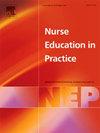美国研究生护士向实践的转变:基于模拟的教育和照顾不同患者的文化意识的观点
IF 3.3
3区 医学
Q1 NURSING
引用次数: 0
摘要
目的本研究探讨了研究生护士(GN)的观点,即基于模拟的教育(SBE)和文化意识在护理不同患者方面如何影响他们向实践的过渡。dgn最终将照顾不同的患者群体。然而,模拟设备通常具有浅色肤色,限制了GNs在实践中遇到的不同患者群体的现实暴露。关于SBE如何使学生能够安全地管理来自不同背景的患者护理的复杂性的证据仍然有限。设计/方法采用个体访谈的方法设计了一项定性探索性研究,以探讨GNs对文化意识和SBE如何使他们为不同的患者提供安全、优质的护理的看法。11个半结构化访谈问题指导数据收集。访谈数据采用反身性主题分析法进行分析。结果:这项研究强调了13 美国GNs向实践的转变受到文化意识和SBE的影响。访谈中产生的四个主题是:(1)通过不同的模拟设备培养文化意识;(2)心理安全作为深入学习的促进因素;(3)内容和情境中嵌入的临床现实主义;(4)致力于培养临床安全。每个主题包括两个辅助的子主题。结论:在SBE中,优先考虑心理安全并强调临床安全,强化了为不同患者群体提供安全、高质量护理的重要性。具有文化包容性的设备和多样化的患者表现增强了临床现实性,培养了GNs的文化意识。总的来说,访谈中产生的主题说明了SBE和文化意识如何显著促进了GNs向专业实践的过渡。本文章由计算机程序翻译,如有差异,请以英文原文为准。
U.S. graduate nurses’ transition into practice: Perspectives on simulation-based education and cultural awareness in caring for diverse patients
Aim
This study explored graduate nurses’ (GN) perspectives of how simulation-based education (SBE) and cultural awareness in caring for diverse patients shaped their transition into practice.
Background
GNs will ultimately care for a diverse patient population. However, simulation equipment often features light-colored skin tones, limiting realistic exposure to diverse patient populations GNs will encounter in practice. Evidence remains limited on how SBE equips students to safely manage the complexities of care for patients from diverse backgrounds.
Design/method
A qualitative exploratory study was designed using individual interviews to explore GNs’ perceptions on how cultural awareness and SBE prepared them to provide safe, quality care for diverse patients. Eleven semi-structured interview questions guided the data collection. The interview data were analyzed using reflexive thematic analysis.
Results
This study highlighted how 13 U.S. GNs’ transition into practice was shaped by cultural awareness and SBE. Four themes generated in the interviews were (1) fostering cultural awareness through diverse simulation equipment, (2) psychological safety as a facilitator for deeper learning, (3) clinical realism embedded in both content and context and (4) dedication to cultivating clinical safety. Each theme included two supporting subthemes.
Conclusion
Prioritizing psychological safety and emphasizing clinical safety in SBE reinforced the importance of delivering safe, high-quality care for a diverse patient population. Culturally inclusive equipment and diverse patient representations enhanced clinical realism and fostered GNs’ cultural awareness. Collectively, the themes generated in the interviews illustrated how SBE and cultural awareness significantly facilitated GNs’ transition into professional practice.
求助全文
通过发布文献求助,成功后即可免费获取论文全文。
去求助
来源期刊

Nurse Education in Practice
NURSING-
CiteScore
5.40
自引率
9.40%
发文量
180
审稿时长
51 days
期刊介绍:
Nurse Education in Practice enables lecturers and practitioners to both share and disseminate evidence that demonstrates the actual practice of education as it is experienced in the realities of their respective work environments. It is supportive of new authors and will be at the forefront in publishing individual and collaborative papers that demonstrate the link between education and practice.
 求助内容:
求助内容: 应助结果提醒方式:
应助结果提醒方式:


